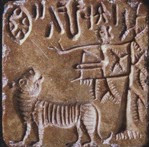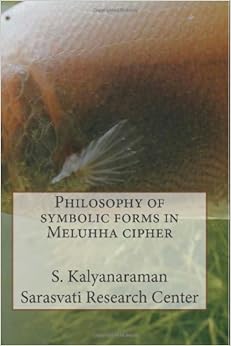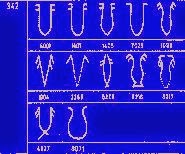This note is a ninth sequel to the work: Philosophy of symbolic forms in Meluhha cipher.
See the first to eighth sequels at:
1.http://bharatkalyan97.blogspot.in/2014/04/meluhha-metallurgy-hieroglyphs-of.html Meluhha metallurgy: hieroglyphs of pomegranate, mangrove date-palm cone (raphia farinifera), an elephant's head terracotta Nausharo, Sarasvati civilization
2.http://bharatkalyan97.blogspot.in/2014/04/ant-twisted-rope-and-other-meluhha.html Twisted rope, ant and other Meluhha hieroglyphs on Ancient Near East and Indian seals3.http://bharatkalyan97.blogspot.in/2014/04/perforated-plaques-of-tello-lagash.html Perforated plaques of Tello, Lagash, Sumerian artifacts, and Meluhha hieroglyphs 4.http://bharatkalyan97.blogspot.in/2014/04/zimrilims-palace-mural-painting-and.html Zimrilim's palace mural painting and Meluhha hieroglyphs (Compliments to Jack M. Sasson) 5. http://bharatkalyan97.blogspot.in/2014/04/tin-road-assur-kanesh-trade.html Tin road -- Assur-Kanesh -- trade transactions and Meluhha hieroglyphs6. http://bharatkalyan97.blogspot.in/2014/04/revisiting-cire-perdue-in.html Revisiting cire perdue in archaeological context and Meluhh7. http://bharatkalyan97.blogspot.in/2014/04/revisiting-ayo-ayas-barbar-temple-seals.html Revisiting ayo, ayas, Barbar temple seals, dhokra kamar, 'cire perdue' specialists and Meluhha hieroglyphs8. http://bharatkalyan97.blogspot.in/2014/04/representations-of-metallurgical.html Representations of metallurgical processes in Meluhha hieroglyphs Meluhha language has left a legacy of lexemes in many Indian languages. India was a sprachbund (language union) in the Bronze Age and many present-day languages, the lingua franca, continue to denote the lexical repertoire which originated in the Bronze Age.
Meluhha cipher, using Meluhha glosses as cypher texts, underlies the use of hieroglyphs (or, 'little fill-elements' on cylinder and other seals and other artifacts such as sculptural friezes) of Ancient India, Ancient Near East and Fertile Crescent. The cypher texts are converted to plain texts substituting Meluhha glosses for the hieroglyphs.
The clusters of Meluhha glosses provide a language framework for reasonably suggesting the phonetic form and underlying meaning of the sememes in the context of life-activities during the early Bronze Age.
In all the cases evidenced by Meluhha cipher, Meluhha sememes are in pairs: one sememe suggesting an identification of a hieroglyph or its allograph and the other sugesting the 'meaning(s)' of a homonymous word(s) in the context of life-activities of the Bronze-age artisans and traders.
The hieroglyph has a frequency of 1395 occurrences in the corpus of Indus script inscriptions (Mahadevan)
Rebus readings as Meluhha hieroglyph of Meluhha language establish the functions served by the deployment of the hieroglyphs on seals/seal impressions used in trade transactions by sea-faring merchants carrying cargo on boats, or merchant caravans of donkey-loads on the Tin Road of the Bronze Age, thus providing a firm archaeological framework for validating the Meluhha cipher:
Hieroglyph: 'rim-of-jar': Phonetic forms: kan-ka (Santali) karṇika (Sanskrit) Rebus: karṇī, supercargo for a boat shipment. karṇīka ‘account (scribe)’.
One-horned young bull together with a 'standard-device' in front is shown on over 1159 epigraphs (c. Corpus of Indus script inscriptions of Mahadevan).
Harappa seal and seal impression, h006
One example is adequate to demonstrate the hieroglyphs of 'one-horned young bull' and 'lathe/portable furnace'. On the text, a 'ladder' hieroglyph occurs: panǰā́r ‘ladder, stairs’(Bshk.)(CDIAL 7760) Rebus: pasra ‘smithy’ (Santali) śrēṇikā f. ʻhouse ~ ladderʼ Rebus:śreṇiin meaning “guild” (Sanskrit) seniya‘soldier’.
Executive summary: The 'standard device' portrays: a collection of tools, implements sangāṭh संगाठ् । सामग्री. The 'one-horned heifer' portrays:an engraver, (producing) turned (metalworked, forged) artifacts.
The hieroglyphs have a number of glyphic elements: one-horn, pannier, young bull, rings on face/neck; gimlet, portable furnace. Rebus Meluhha readings of the hieroglyphs provide the 'meaning' intended by the scribe.
sangaḍa 'lathe, furnace'. Rebus: sang ‘stone’, gaḍa ‘large stone’.sã̄gāḍā m. ʻ frame of a building ʼ; sangara ‘fortification’; Rebus: jangaḍ 'entrustment note' (Gujarati) jangaḍ accounting for mercatile transactions ‘goods entrusted on approval basis’. (Gujarati) sangāṭhसंगाठ् । सामग्री m. (sg. dat. sangāṭas संगाटस् ), a collection (of implements, tools, materials, for any object), apparatus, furniture, a collection of the things wanted on a journey, luggage (Kashmiri)
sangaḍa 'lathe, furnace'. Rebus: sang ‘stone’, gaḍa ‘large stone’.sã̄gāḍā m. ʻ frame of a building ʼ; sangara ‘fortification’; Rebus: jangaḍ 'entrustment note' (Gujarati) jangaḍ accounting for mercatile transactions ‘goods entrusted on approval basis’. (Gujarati) sangāṭh
खोंडी [ khōṇḍī ] f An outspread shovelform sack (as formed temporarily out of a कांबळा, to hold or fend off grain, chaff &c.) (Marathi) kondh ‘heifer’. kōḍu horn (Kannada. Tulu. Tamil) Rebus: Bshk. kōr ʻlarge stoneʼ (CDIAL 3018). Rebus: koḍ ’workshop’.
खोंड [khōṇḍa] m A young bull, a bullcalf. (Marathi) Rebus: kõdā ‘lathe-turner’. kũdār ‘turner, brass worker’. कोंद kōnda ‘engraver, lapidary setting or infixing gems’ (Marathi) kũdār, kũdāri (B.); kundāru (Or.); kundau to turn on a lathe, to carve, to chase; kundau dhiri = a hewn stone; kundau murhut = a graven image (Santali) kunda a turner's lathe (Skt.)(CDIAL 3295). Rebus: कोंड [kōṇḍa] A circular hamlet; a division of a मौजा or village, composed generally of the huts of one caste. कोंडण [kōṇḍaṇa] f A fold or pen. (Marathi) खोट [khōṭa] Alloyed--a metal (Marathi).
Indus script “fish-eyes” were traded with Ur as evidenced by cuneiform texts.
Rebus Meluhha readings of the hieroglyphs provide the 'meaning' of the phrase: 'fish-eyes' used in cuneiform texts.
Hieroglyph: ayo ‘fish’ Rebus: ayo‘iron’. ayah, ayas = metal (Sanskrit)
For example, the hieroglyphs deployed on some cylinder seals (Elamite and other Ancient Near East) presented are: ram, culm (stalk or little tree), star, aquatic bird, seated person with bull's horns. These hieroglyphs are read rebus in the context of bronze-age artifacts, the products of Meluhha artisan competence.
karaṛa‘a very large aquatic bird’ (Sindhi) Rebus: करडा [karaḍā] Hard from alloy--iron, silver &c. A color of horses, iron grey.
Or. kāṇḍa, kã̄ṛ ʻstalk, arrow ʼ(CDIAL 3023).Rebus: khāṇḍā ‘tools, pots and pans, metal-ware’.
खांडा [ khāṇḍā ] m A jag, notch, or indentation (as upon the edge of a tool or weapon). (Marathi) Rebus: khāṇḍā ‘tools, pots and pans, metal-ware’.
ṭagara 'ram' Rebus: damgar 'merchant' (Akkadian) ṭhakkura,‘idol’, ṭhākur ʻ blacksmith ʼ, ṭhākur m. ʻmaster’.ḍhangar ‘blacksmith’.
meḍha ‘polar star’ (Marathi). meḍ ‘iron’ (Ho.Mu.)
kōḍu horn (Kannada. Tulu. Tamil) Rebus 1: Bshk. kōr ʻlarge stoneʼ (CDIAL 3018). Rebus2: koḍ ’workshop’.
Hieroglyph: stalk, thorny
S. kã̄ḍo ʻ thorny ʼ (CDIAL 3022).kāˊṇḍa (kāṇḍá -- TS.) m.n. ʻ single joint of a plant ʼ AV., ʻ arrow ʼ MBh., ʻ cluster, heap ʼ (in tr̥ṇa -- kāṇḍa -- Pāṇ. Kāś.). [Poss. connexion with
Hieroglyph: division across the length
कांडारा [ kāṇḍārā ] m (कांड ) A division across the length (as of a bamboo, sugarcane, plantain-stem, or similar small trunk). 2 (कांडणें ) Chaff separated from corn by pounding.(Marathi) Rebus: khāṇḍā ‘tools, pots and pans, metal-ware’. āra'brass'.
खांडा [ khāṇḍā ] A jag, notch, or indentation (as upon the edge of a tool or weapon). A rough furrow, ravine, gully. (Marathi)
Rebus: pots and pans, metal tools
खांडा [ khāṇḍā ] m A kind of sword, straight, broad-bladed, two-edged, and round-ended. H. lokhaṇḍ m. ʻ iron tools, pots and pans ʼ; G. lokhãḍ n. ʻ tools, iron, ironware ʼ; M. lokhãḍ n. ʻ iron ʼ (LM 400 < -- khaṇḍa -- ).*lōhōpaskara ʻ iron tools ʼ. [lōhá -- , upaskara -- 1 ]N. lokhar ʻ bag in which a barber keeps his tools ʼ; H. lokhar m. ʻ iron tools, pots and pans ʼ; -- X lauhabhāṇḍa -- : Ku. lokhaṛ ʻ iron tools ʼ; (CDIAL 11171) laúha -- ʻ made of copper or iron ʼ Gr̥Śr., ʻ red ʼ MBh., n. ʻ iron, metal ʼ Bhaṭṭ. [lōhá -- ]Pk. lōha -- ʻ made of iron ʼ; L. lohā ʻ iron -- coloured, reddish ʼ; P. lohā ʻ reddish -- brown (of cattle) ʼ.[Dial. au ~ ō (in lōhá -- ) < IE. ou T. Burrow BSOAS xxxviii 74](CDIAL 11172a) 11173 lauhabhāṇḍa n. ʻ iron pot, iron mortar ʼ lex. [laúha -- , bhāṇḍa -- 1 ]Pa. lōhabhaṇḍa -- n. ʻ copper or brass ware ʼ; S. luhã̄ḍ̠iṛī f. ʻ iron pot ʼ, L.awāṇ. luhã̄ḍā; P. luhã̄ḍā, lohṇḍā, ludh. lō̃hḍā m. ʻ frying pan ʼ; N. luhũṛe ʻ iron cooking pot ʼ; A. lohorā ʻ iron pan ʼ; Bi. lohãṛā ʻ iron vessel for drawing water for irrigation ʼ; H. lohaṇḍā, luh° m. ʻ iron pot ʼ; G. loḍhũ n. ʻ iron, razor ʼ, pl. ʻ car<-> penter's tools ʼ,loḍhī f. ʻ iron pan ʼ(CDIAL 11173).
Rebus: sangāṭh संगाठ् । सामग्री m. (sg. dat. sangāṭas संगाटस् ), a collection (of implements, tools, materials, for any object), apparatus, furniture, a collection of the things wanted on a journey, luggage, and so on. -- karun -- करुन् । सामग्रीसंग्रहः m.inf. to collect the ab. (L.V. 17).(Kashmiri)
Reference to a cargo: hārka
Reference to a cargo: hārka
 Mohenjo-daro m0309 Seal. Hieroglyph: khōṇḍa 'leafless tree' (Marathi). Rebus: kõdār 'turner' (Bengali);kõdā ‘to turn in a lathe’ (Bengali).कोंद kōnda ‘engraver, lapidary setting or infixing gems’ (Marathi)
Mohenjo-daro m0309 Seal. Hieroglyph: khōṇḍa 'leafless tree' (Marathi). Rebus: kõdār 'turner' (Bengali);kõdā ‘to turn in a lathe’ (Bengali).कोंद kōnda ‘engraver, lapidary setting or infixing gems’ (Marathi) https://www.academia.edu/6574626/Near_East_cylinder_seals_tell_small_histories Tom van Bakel provides evidences of cylinder seals with 'fill elements'. I call them hieroglyphs.
The following are some examples from Tom van Bakel:

Seal published: The seal cylinders of Western Asia The cuneiform inscription reads: "Hu-uku-
ili, patesi of Mash, Governor of Madka”, since he crushed Unu, the servant of Zini."

Seal published: The Elamite Cylinder seal corpus c. 3500-1000 BCE
Seal published: The Elamite Cylinder seal corpus: c. 3500-1000 BCE

Seal published: The Elamite Cylinder seal corpus: c. 3500-1000 BCE.
Mirrored at: https://www.academia.edu/6898842/Meluhha_hieroglyphs_on_cylinder_and_other_seals_of_Bronze_Age








